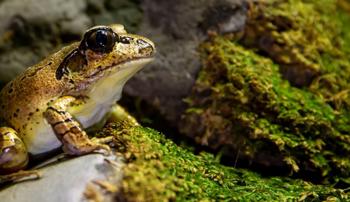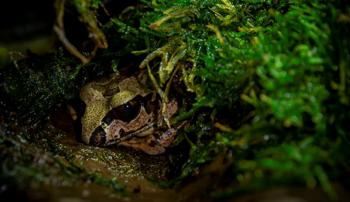Southern Barred Frog (previously known as Stuttering Barred Frog)
Populations of Southern Barred Frogs are fast disappearing.
This species was recently split, and the species known from Victoria has not been recorded since 1982 and may be extinct in the State. Females may reach 80mm in length, males are slightly smaller. The Southern Barred Frog lives near fast-flowing streams in wet forests along the east coast of Australia, from north-eastern Victoria to the Carrai Plateau, just north of Port Macquarie in New South Wales.
Yellow grey in colour, it is known as the Southern Barred Frog because of the narrow, dark bands on its arms and legs. It is also known as the Stuttering Frog because of their stuttering 'op' call. They can often sound like a kookaburra in a hurry!

Major threats
Despite several surveys for the species, the Southern Barred Frog has not been recorded in Victoria for more than 40 years. It is likely that the devastating disease chytridiomycosis, caused by a fungus on the skin of the frog, has contributed to severe declines in this species. Other threats include logging and associated activities in forests, and damage caused by invasive species such as deer, and land clearing in the water catchments where it occurred. Climate change, and associated issues such as droughts and more frequent, severe, and large bushfires are also significant threats to this frog.
Southern Barred Frogs are also in danger from introduced fish that prey on its eggs and tadpoles.

The plan for fighting extinction
Zoos Victoria is continuing efforts to re-find this species within its former range in Victoria.
How you can help
- Visiting our zoos supports our work to fight extinction.
- Donate if you can. We are a not-for-profit organisation, and all donations go towards our important conservation efforts.
- Discover more about local conservation events and join the growing number of wild activists taking action for wildlife.
Is your classroom learning about the Southern Barred Frog?
Browse through our collection of animal teaching and learning resources for students. These include animal toolkits, e-books, Ask a Zoo Expert resources, video showcases and real-world examples to support the VCE Study Design.
